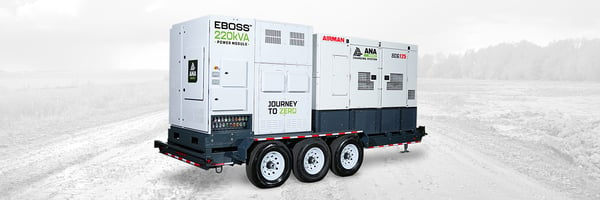Introduction As energy needs grow more complex and grid instability becomes a regular concern,...
Evaluating LTO vs. LFP: Why Power Output Matters More Than Capacity
Rethinking the Way We Compare Battery Systems
As rental fleets, contractors, and site operators look to hybrid and mobile power systems to reduce fuel use and maintenance costs, the challenge is clear: balancing performance, reliability, and long-term value. Yet one of the most common challenges in evaluating energy storage technologies is choosing the right metric for comparison.
For equipment rental companies, understanding these differences goes beyond comparing specs. It influences uptime, fuel savings, and total cost of ownership for both hybrid systems and traditional diesel-supported operations.
When Lithium Titanium Oxide (LTO) is compared with Lithium Iron Phosphate (LFP) or Nickel Manganese Cobalt (NMC), the most common measure used is cost per kilowatt-hour ($/kWh). On paper, this can make LTO seem more expensive.
In reality, it’s not always a fair comparison.
LTO is not designed for long-duration energy storage. It’s built around power, cycling capability, and uptime. Understanding that difference helps clarify how its value should be measured.
Why $/kVA Is a Better Lens
That’s why evaluating based solely on energy storage cost can overlook how the system actually performs in the field.
For hybrid systems, a more accurate way to evaluate cost and performance is by looking at $/kVA (cost per unit of power) rather than $/kWh (cost per unit of energy stored).
Example:
-
Average LFP Mobile BESS: 250 kVA system at $375,000 → $1,500/kVA
-
Average LTO Mobile System: 250 kVA system at $369,000 → $1,476/kVA
When measured this way, the LTO system is slightly lower in cost per kVA while offering greater durability and performance benefits over time.
1. Power Over Storage: Built for Heavy Cycling and Efficiency
In generator-hybrid systems, the goal is not simply to store energy but to manage load effectively, reduce fuel consumption, and extend generator life.
LTO batteries perform well in these environments because they are designed for rapid charge and discharge (4C–8C rates) and frequent cycling, often reaching 15,000–20,000 cycles in demanding field applications such as rental, telecom, and construction power.
By comparison, LFP and NMC chemistries typically achieve between 2,000 and 4,000 cycles before showing signs of degradation. Over a system’s lifespan, that difference can have a measurable impact on operational efficiency and cost savings.
2. Proven Longevity: Longer Life, Lower Downtime
Field data from ANA’s systems show that LTO-based designs can reach:
- More than 90,000 lifetime charge and discharge cycles
- Battery lifespans of up to 40 years
- Charge times under one hour, compared to four to six hours for LFP or NMC
This combination of efficiency and durability helps reduce downtime, extend system life, and lower long-term ownership costs. These characteristics are particularly valuable in industries that depend on continuous or mission-critical power availability.
3. Safety and Sustainability Advantages
LTO chemistry also provides significant safety benefits. Unlike some other lithium chemistries, LTO is highly stable and not prone to thermal runaway, even if the cells are punctured or flooded.
This stability makes it well-suited for demanding applications in construction, telecom, microgrids, and disaster response, where conditions can be unpredictable. It also performs consistently across a wide temperature range, maintaining power delivery without significant losses in efficiency.
4. Real-World Results: Compact, Fast, and Reliable
In side-by-side comparisons, ANA’s EBOSS hybrid platform demonstrates the tangible advantages of LTO in power-focused environments. Below is a high-level look at how LTO compares with other chemistries in power-focused mobile systems.
| Feature | LTO | LFP/NMC |
|---|---|---|
| Battery Life Expectancy | Up to 40 years | 5–10 years |
| Lifetime Cycles | 90,000+ | 2,000–4,000 |
| Charge Time | <1 hour | 4–6 hours |
| Thermal Runaway Risk | None | Possible |
| Packaging Efficiency | 3–4x smaller and lighter | Larger, heavier |
| Wet-Stacking Risk (Diesel Gen) | None | Yes |
These metrics underscore a simple truth: LTO is the chemistry of uptime. It’s engineered not to store energy, but to optimize it.
5. Choosing the Right Metric
It’s easy to focus on $/kWh when comparing technologies, but that measure alone doesn’t always capture how a system performs under real-world, power-intensive conditions. $/kVA provides a clearer picture of how efficiently and reliably that power can be delivered and reused over time.
While LTO systems may appear more expensive at first glance, evaluating them through this lens often reveals their long-term value. In many hybrid and high-cycle applications, the right metric helps uncover the full picture of efficiency, reliability, and cost of ownership.
Key Takeaway:
Measuring systems by $/kVA instead of $/kWh offers a clearer view of real-world performance and value. For rental and hybrid power users, this metric highlights what truly matters - uptime, efficiency, and long-term reliability.
ANA Insight
At ANA, Inc., our focus is on designing smarter hybrid systems that help our rental and industrial partners manage power more efficiently, safely, and sustainably. By incorporating LTO technology, our EBOSS platform delivers measurable gains in uptime, service efficiency, and fuel savings, proving that smarter energy storage means stronger performance in the field.
Learn more about how LTO-based EBOSS systems are helping redefine mobile and hybrid power:
Visit ANA’s EBOSS Hybrid Power Systems

.png?width=549&height=400&name=SCIB%20battery%20detail%20view%20v3%20(edit).png)

.jpg?height=200&name=IMG_3861%20(edit%20-%2035%20op).jpg)
.png?height=200&name=Equipment%20Today%202025%20Award%20(2).png)